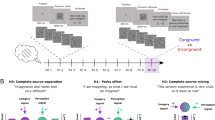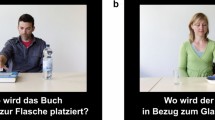Abstract
Perspective taking is an essential component in the mechanisms that account for intersubjectivity and agency. Mental simulation of action can be used as a natural protocol to explore the cognitive and neural processing involved in agency. Here we took PET measurements while subjects simulated actions with either a first-person or a third-person perspective. Both conditions were associated with common activation in the SMA, the precentral gyrus, the precuneus and the MT/V5 complex. When compared to the first-person perspective, the third-person perspective recruited right inferior parietal, precuneus, posterior cingulate and frontopolar cortex. The opposite contrast revealed activation in left inferior parietal and somatosensory cortex. We suggest that the right inferior parietal, precuneus and somatosensory cortex are specifically involved in distinguishing self-produced actions from those generated by others.
This is a preview of subscription content, access via your institution
Access options
Subscribe to this journal
Receive 12 print issues and online access
$209.00 per year
only $17.42 per issue
Buy this article
- Purchase on Springer Link
- Instant access to full article PDF
Prices may be subject to local taxes which are calculated during checkout




Similar content being viewed by others
References
Gopnik, A. & Meltzoff, A. N. Words, Thoughts, and Theories (MIT Press, Cambridge, Massachussetts, 1998).
Gallese, V. & Goldman, A. Mirror neurons and the simulation theory of mind-reading. Trends Cogn. Sci. 2, 493–501 (1998).
Goldman, A. in Metarepresentations: A Multidisciplinary Perspective (ed. Sperber, D.) 171–196 (Oxford University Press, New York, 2000).
Daprati, E. et al. Looking for the agent: an investigation into consciousness of action and self-consciousness in schizophrenic patients. Cognition 65, 71–86 (1997).
Gallagher, S. Philosophical conceptions of the self: implications for cognitive science. Trends Cogn. Sci. 4, 14–21 (2000).
Decety, J. in The Imitative Mind: Development, Evolution, and Brain Bases (eds. Meltzoff, A. N. & Prinz, W.) (Cambridge Univ. Press, Cambridge, UK, in press).
Decety, J. et al. Mapping motor representations with positron emission tomography. Nature 371, 600–602 (1994).
Stephan, K. M. et al. Functional anatomy of the mental representation of upper extremity movements in healthy subjects. J. Neurophysiol. 73, 373–386 (1995).
Lotze, M. et al. Activation of cortical and cerebellar motor areas during executed and imagined hand movements: an fMRI study. J. Cogn. Neurosci. 11, 491–501 (1999).
Ochipa, C. et al. Selective deficit of praxis imagery in ideomotor apraxia. Neurology 49, 474–480 (1997).
Sirigu, A. et al. The mental representation of hand movements after parietal cortex damage. Science 273, 1564–1568 (1996).
Grèzes, J. & Decety, J. Functional anatomy of execution, mental simulation, observation and verb generation of actions: a meta-analysis. Hum. Brain Mapp. 12, 1–19 (2001).
Gerardin, E. et al. Partially overlapping neural networks for real and imagined hand movements. Cereb. Cortex 10, 1093–1104 (2000).
Jeannerod, M. Mental imagery in the motor context. Neuropsychologia 33, 1419–1432 (1995).
Iacoboni, M. et al. Cortical mechanisms of human imitation. Science 286, 2526–2528 (1999).
Goebel, R., Khorram-Sefat, D., Muckli, L., Hacker, H. & Singer, W. The constructive nature of vision: direct evidence from functional magnetic resonance imaging studies of apparent motion and motion imagery. Eur. J. Neurosci. 10, 1563–1573 (1998).
Stevens, J. A., Fonlupt, P., Shiffrar, M. & Decety, J. New aspects of motion perception: selective neural encoding of apparent human movements. Neuroreport 11, 109–115 (2000).
Tootell, R. B. et al. Visual motion aftereffect in human cortical area MT revealed by functional magnetic resonance imaging. Nature 375, 139–141 (1995).
O'Craven, K. M., Rosen, B. R., Kwong, K. K., Treisman, A. & Savoy, R. L. Voluntary attention modulates fMRI activity in human MT-MST. Neuron 18, 591–598 (1997).
Kourtzi, Z. & Kanwisher, N. Activation in human MT/MST by static images with implied motion. J. Cogn. Neurosci. 12, 48–55 (2000).
Decety, J. et al. Brain activity during observation of actions. Influence of action content and subject's strategy. Brain 120, 1763–1777 (1997).
Grèzes, J., Costes, N. & Decety, J. Top-down effect of strategy on the perception of human biological motion: PET investigation. Cogn. Neuropsychol. 15, 553–582 (1998).
Mesulam, M. M. Dissociative states with abnormal temporal lobe EEG. Multiple personality and the illusion of possession. Arch. Neurol. 38, 176–181 (1981).
Spence, S. A. et al. A PET study of voluntary movement in schizophrenic patients experiencing passivity phenomena (delusion of alien control). Brain 120, 1997–2011 (1997).
Rainville, P. et al. Cerebral mechanisms of hypnotic induction and suggestion. J. Cogn. Neurosci. 11, 110–125 (1999).
Maquet, P. et al. Functional neuroanatomy of hypnotic state. Biol. Psychiatry 45, 327–333 (1999).
Bisiach, E. & Berti, A. in The Cognitive Neurosciences (ed. Gazzaniga, M. S.) 1331–1340 (MIT Press, Cambridge, Massachusetts, 1995).
Wolpert, D. M., Goodbody, S. J. & Husain, M. Maintaining internal representations: the role of the human superior parietal lobe. Nat. Neurosci. 1, 529–533 (1998).
Hurley, S. L. Non-conceptual self-consciousness and agency: perspective and access. Commun. Cognit. 30, 207–248 (1997).
Kircher, T. T. et al. Towards a functional neuroanatomy of self processing: effects of faces and words. Cogn. Brain Res. 10, 133–144 (2000).
Brunet, E., Sarfati, Y., Hardy-Bayle, M. C. & Decety, J. A PET investigation of the attribution of intentions with a nonverbal task. Neuroimage 11, 157–166 (2000).
Fletcher, P. C. et al. Other minds in the brain: a functional imaging study of “theory of mind” in story comprehension. Cognition 57, 109–128 (1995).
Kalus, P., Muller, T. J., Zuschratter, W. & Senitz, D. The dendritic architecture of prefrontal pyramidal neurons in schizophrenic patients. Neuroreport 11, 3621–3625 (2000).
Selemon, L. D. & Goldman-Rakic, P. S. The reduced neuropil hypothesis: a circuit based model of schizophrenia. Biol. Psychiatry 45, 17–25 (1999).
Lhermitte, F., Pillon, B. & Serdaru, M. Human autonomy and the frontal lobes. Part I: Imitation and utilization behavior: a neuropsychological study of 75 patients. Ann. Neurol. 19, 326–334 (1986).
Friston, K. J. et al. Statistical parametric maps in functional imaging: a general linear approach. Hum. Brain Mapp. 3, 189–210 (1995).
Talairach, P. & Tournoux, J. A. Co-Planar Stereotaxic Atlas of the Human Brain (Thieme, Stuttgart, 1988).
Duvernoy, H. M. The Human Brain. Surface, Three-Dimensional Sectional Anatomy and MRI (Springer, New York, 1991).
Acknowledgements
This research was supported by the Cognitique Programme from the French Ministry of Education. We thank A. Goldman (University of Arizona, Tucson) and A. Meltzoff (University of Washington, Seattle) for their comments during the preparation of the manuscript. D. Cardebat (Inserm unit 455, Toulouse, France) gave us advice on the experimental protocol.
Author information
Authors and Affiliations
Corresponding author
Rights and permissions
About this article
Cite this article
Ruby, P., Decety, J. Effect of subjective perspective taking during simulation of action: a PET investigation of agency. Nat Neurosci 4, 546–550 (2001). https://doi.org/10.1038/87510
Received:
Accepted:
Issue Date:
DOI: https://doi.org/10.1038/87510
This article is cited by
-
Development and feasibility of first- and third-person motor imagery for people with stroke living in the community
Pilot and Feasibility Studies (2023)
-
Young adults’ empathic responses to others in psychological pain as compared to physical pain: does prior experience of pain matter?
Current Psychology (2023)
-
Cognitive mechanisms of observing others touching products increases purchasing intention: An eye-tracking study
Current Psychology (2023)
-
Motor imagery training of goal-directed reaching in relation to imagery of reaching and grasping in healthy people
Scientific Reports (2022)
-
Social synchronization of brain activity increases during eye-contact
Communications Biology (2022)



